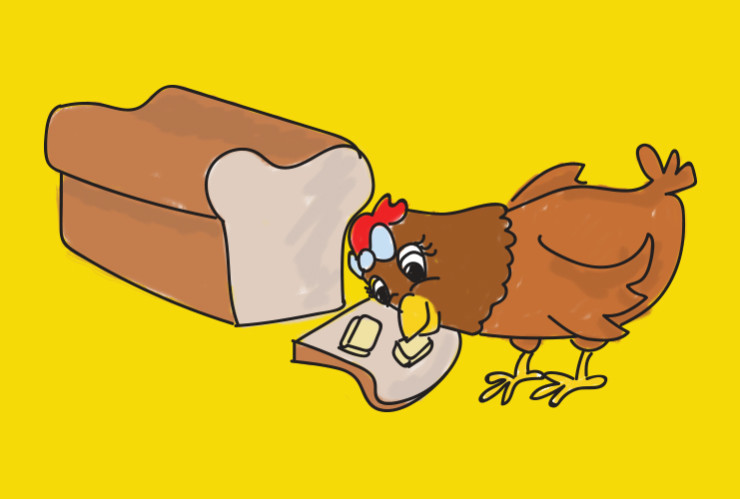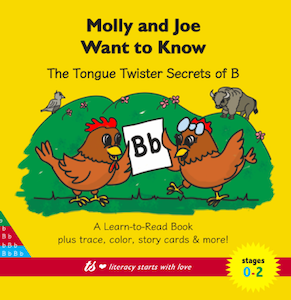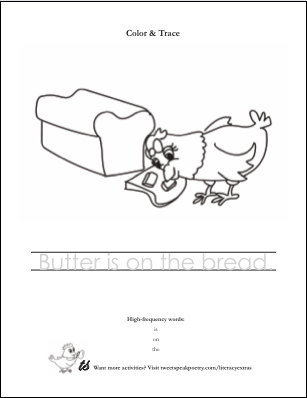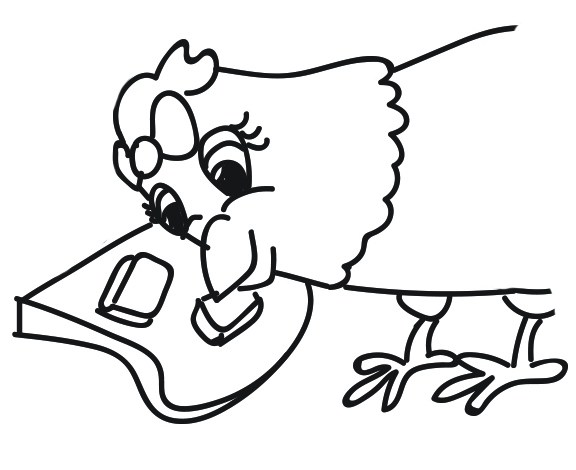Now, you can help a child learn to read with the young chickens Molly and Joe—two wide-eyed early readers who are full of curiosity, mischief, and mirth! Rich language and amusing illustrations combine with strategies that address how the brain remembers best: pattern, repetition, visual novelty, and multi-sensory experiences.
Children demonstrate six reading stages, from zero to five (print awareness to analysis and reasoning). Our first multi-level Molly and Joe Want to Know reader serves stages zero to two: print awareness, sound and letter pairing, and automatic reading.
You can use the Reader to read for pleasure (even for babies!); then teach the letter b; then teach or reinforce other sound/letter relationships, high-frequency words, new vocabulary, and writing.
In a move-quickly-from-one-thing-to-the-next culture, it can be surprising to learn that stage two learners benefit from repeated experience with the same texts and materials, until reading is automatic. To make the necessary repetition easy and fun, we’ve included simple games with cut-out materials (all reusable) and activities in the Reader. You’ll find Color & Trace Pages, Biscuit Bingo, Story Cards (for Matching, Story Train, Partners in Rhyme, and Story Challenge games), Letter Dress-Up Cards (for sound and letter associations and word building), and Sentence Builders.
Color and Trace “Butter is On the Bread”
Our Color & Trace pages help teach high-frequency words, develop fine motor skills and handwriting, and solidify memory of the letter b or other sound/letter relationships. If you’ve already got the Molly and Joe reader, then you have a version of “Butter is on the bread” that teaches other high-frequency words.
So maybe you’re looking for extra, fun reading activities to support the learn-to-read journey. To that end, we’re sharing: “Butter is on the bread.” (Molly is that delightful little chicken trying to butter her bread with her beak!)
5 Fun Facts About Butter
1. It takes 21 pints of milk to make just a pound of butter (that set of four sticks you buy at the store). That’s like six straight weeks of school lunch milk cartons!
2. The color of butter depends on what the cows eat. The more carotene (a pigment in the grasses used to make hay), the more yellow the butter will be.
3. Butter has historically had a lot of significance in cultural traditions. Vikings, who were also known as “butter eaters,” were known to be buried with vats of butter. And in pre-Elizabethan England, people would give butter as wedding gifts because it was thought to be a symbol of wealth and fertility.
4. The melting temperature for butter is 98.6 degrees. That’s the same temperature as the human body, so it melts when we put it in our mouth!
5. Butter is made from separating the cream from milk and then “churning” (shaking it up) it for a very long time. In ancient times, the cream was poured into a goatskin that was hung and spun around. Now it’s made in giant stainless steel tanks, like you can see in this video about making butter.
Butter Limerick Poetry Prompt
Try your hand at a butter limerick. Use the “fun facts” as inspiration if you like. Need more inspiration? Check out our limerick infographic.
This book is so much fun! I used it with about 10 Kindergarten and first graders who are labeled as “at-risk,” (I like to call them my promising students), and we had a blast reading the poem and doing the activities. The poem produces giggles and conversation, and the activities are easy to prepare and fun to complete! Plus, I love that I can use the activities over again. This is a must have in a teacher’s classroom.
—Callie Feyen, at-risk literacy specialist
- Poetry Prompt: Gathering Flowers - June 16, 2025
- Poetry Prompt: The Phoenix - May 26, 2025
- 10 Ways to Help Your Favorite Introverted Author: 1,000 Words - May 23, 2025




L.L. Barkat says
I LOVED that butter video. What a totally cool process. (The popcorn butter phase was especially fun.)
lynn__ says
Yes, it was an interesting video! We have a cheese plant in our town. Those cows “work” hard to supply all that milk, butter and cheese so I wrote an udderly bountiful limerick:
Introducing a bovine named Daisy
She’s a generous cow, never lazy
her milk is a dream
of rich butter cream
she gives away gallons like crazy!
As an educator, I’m intrigued by the Molly & Joe series 🙂
L.L. Barkat says
What a fun limerick, Lynn! 🙂
We’d love to hear what intrigues you about the series, if you are able to pinpoint that. (As an educator myself, this is the kind of book I wish I’d had when I was working with new readers.)
lynn says
I agree…my home schooled sons have all graduated but wish I could have used these books. The sensory experiences is a great idea and I think the illustrations are adorable! We live on a farm and enjoyed raising a few chickens 🐔
Katie says
lynn, this limerick is so fun, I laughed out loud!
I fudged a bit on mine – it’s a cross between an acrostic and a limerick and has one too many lines for a limerick. Still fun to write:)
Katie says
Butter comes from milk
Utterly smooth as silk
Tempting me
Teasing me
Every pat pleasing me,
Really – you know it’s ilk.
Luci Shaw says
Hi, here’s my butter limerick:
Traditional churners of butter
are known to both flutter and mutter.
When cream doesn’t congeal
we know how they feel
by the direful curses they utter
Monica Sharman says
Good one, Luci! Maybe it’s not just the churners but the churned who utter direful curses …
Here’s my limerick:
You’ll need, for the making of butter,
a stool and (ahem) a good udder.
Every day, you should milk her
or she’ll be off-kilter
and edgy and restless and fluttered.
Katie says
Luci and Monica,
Your limericks made me laugh out loud – SO fun!
Thanks for sharing:)
I can recall some butter molds my mom had kept from the farm she grew up on.
Pretty carving of wheat sheaves on one, don’t remember the other design.
Sandra Heska King says
Love limericks. Slipping in late…
Joe Butter once got a bad rap
When accused of extending my lap.
But the charge didn’t stick,
and K2’s now the pick
to tighten my belt; that’s a wrap.